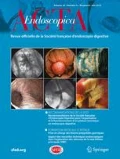Résumé
Nous rapportons le cas d'une patiente âgée de 23 ans, hospitalisée pour bilan d'une diarrhée glairo-sanglante. La colonoscopie et les biopsies coliques ont permis le diagnostic de maladie de Crohn (MC). La patiente a été mise sous mésalazine. L'évolution a été marquée par la disparition des émissions glairo-sanglantes et une diminution de la diarrhée. Une gastroscopie pratiquée à la recherche d'une localisation gastrique et/ou duodénale a révélé l'existence d'une atrophie villositaire totale. Devant la suspicion d'une maladie coeliaque (MCA), le bilan a été complété par une étude immunologique qui a mis en évidence des anticorps anti-gliadine et des anticorps anti-endomysium. La patiente a été mise sous régime sans gluten associé à la mésalazine. Une rémission clinique, biologique et histologique a été notée pendant deux ans, puis une atteinte proctologique de la maladie de Crohn est apparue.
A l'occasion de cette observation, nous soulignons la rareté de l'association de la maladie de Crohn et de la maladie cœliaque. Nous insistons également sur l'étiopathogénie complexe de la maladie cœliaque qui pourrait avoir des points communs avec celle de la maladie de Crohn, particulièrement aux plans immunologiques et génétiques.
Summary
We report the case of a 23 year-old female patient, hospitalized for the evaluation of bleeding diarrhea with glairs. The colonoscopy and colonic biopsies allowed for a diagnosis of Crohn's disease (CD). The patient was treated with mesalazine. The evolution showed the disappearing of the bloody and glairy emissions and a decrease of the diarrhea. A gastroscopy performed in order to search for a duodenal and/or gastric localization revealed a total atrophy of the villi. In the face of a suspicion of coeliac disease (CoD), the evaluation was completed with an immunolo study which revealed anti-gliadine and anti-endomysium antibodies. The patient was subjected to a gluten-free diet associated with mesalazin. A clinical, biological and histological remission was observed for two years, then a proctologic form of Crohn's disease occurred.
In the face of this observation, we want to emphasize that the association of Crohn's disease with coeliac disease is a very rare occurrence. We also insist on the complex etiopathogeny of coeliac disease which could have common points with that of Crohn's disease, in particular from immunological and genetic points of view.
Références
LENNARD-JONES J.E. — Classification of inflammatory bowel disease.Scand. J. Gastroenterol.,24 (suppl 170), 2–6.
TRIER J.S. — Diagnosis of coeliac sprue.Gastroenterology, 1998,115, 211–216.
EKBOM A., HELMICK C., ZACK M., ADAMI H.O. — The epidemiology of inflammatory bowel disease: a large, population-based study in Sweden.Gastroenterology, 1991,100, 350–358.
MEHDI A., BACCOUCHE A., SKANDRANI K.et al. — Epidémiologie des maladies inflammatoires cryptogénétiques de l'intestin dans le centre-est tunisien.Maghreb Médical, 1997,314, 47–52.
Clinicopathological Conference. — A case of Crohn's disease in a patient with treated adult coeliac disease.Br. Med. J., 1967,2, 222–226.
DENIE C. — Foie et maladie cœliaque.Hépato Gastro, novembre-décembre 2000, 302–304.
CURTIS W.D., SHUMAN B.M., GRIFFIN J.W. Jr. — Association of gluten-sensitive enteropathy and Crohn's colitis.Am. J. Gastroenterol., 1992,87, 1634–1637.
KITIS G., HOLMES G.K.T., COOPER B.T., THOMPSON H., ALLAN R.N. — Association of coeliac disease and inflammatory bowel disease.Gut, 1980,21, 636–641.
KARRAS A., CAILLAT-ZUCMAN S. — Transglutaminase tissulaire: un auto-antigène clé dans la maladie cœliaque.Hépato Gastro, septembre–octobre 1999, 405–408.
COLOMBEL J.F., DESREUMAUX P. — Physiopathologic des maladies inflammatoires chroniques de l'intestin.In: Rambaud J.C. Les maladies inflammatoires chroniques de l'intestin. Paris, John Libbey Eurotext, 1998, 27–46.
QUINTON J.F., SENDID P., REUMAUX D.et al. — Anti-Saccharomyces cerevisiae mannan antibodies combined with antibody in inflammatory bowel diseases: prevalence and diagnostic.Gut, 1998,42, 788–791.
WASHINGTON Aga-D.D.W. — Maladie cœliaque de l'adulte, épidémiologie, traitement.Méd. Chir. Dig., 1997,26, 355–356.
COTTON M., CAPPELLO M., PUELO A., CIPPOLA C., FILIPPAZO M.G. — Familial association of Crohn's and coeliac diseases.Lancet, 1989,2, 338.
Author information
Authors and Affiliations
About this article
Cite this article
Bencheqroun, R., Florent, C., Nawal, K. et al. Une association rare: maladie de Crohn et maladie coeliaque. Acta Endosc 33, 385–388 (2003). https://doi.org/10.1007/BF03015753
Issue Date:
DOI: https://doi.org/10.1007/BF03015753

